Thank you for visiting! By the way… any links on this page that lead to products on Amazon and other stores/partners are affiliate links Aquarium Store Depot earns a commission if you make a purchase.
Nothing looks more stunning than a large aquarium filled with cichlids. No matter if you have African, Central American, South American, or another common type of cichlid, these tropical fish can bring immense color and excitement to the home aquarium.
But what if you want a break from cichlids? Can you add other species to your cichlid aquarium?
The answer to this question depends on several factors including tank size and setup as well as the different kinds of cichlid being kept.
Keep reading to find out all the different tank cichlid tank mates option you might have for African cichlids, South American cichlids, and other popular cichlid species!
Key Takeaways
- Contrary to popular belief, cichlids can have tank mates!
- There are three main types of cichlid: African cichlids, Central American cichlids, and South American cichlids.
- Aggression varies from species to species and tank mate pairings will greatly depend upon compatibility with other fish, along with water parameters and tank setup.
- African cichlids have the least flexibility in terms of tank mates while South American species have some of the greatest.
Understanding What Type You Have
First, you need to determine what type of cichlid you have. All cichlids are capable of being aggressive, but some can be kept in community tank setups while others can only be kept with members of their own kind.
Luckily, most aquarium stores accurately name their cichlids so you don’t need to wonder what kind you’re taking home. Here are some of the most common cichlids you’ll find.
African Cichlids

African cichlids mainly originate from two freshwater lakes in Africa: Lake Malawi1 and Lake Tanganyika. Lake Malawi cichlids, including Mbuna cichlids, tend to be more colorful but more aggressive than Lake Tanganyika species.
Lake Malawi cichlids include:
- Electric yellow cichlid (Labidochromis caeruleus). These fish grow to 5-7 inches and are bright yellow with black-trimmed fins.
- Demasoni cichlid (Pseudotropheus demasoni). Demasoni cichlids reach mature sizes between 3-5 inches and thrive in groups. They have alternating black and blue stripes.
- Aulonocara spp. Commonly known as the Lake Malawi peacock cichlids, members of the Aulonocara genus come in reds, blues, and yellows, and grow to about 4-6 inches.
Lake Tanganyika cichlids include:
- Frontosa (Cyphotilapia frontosa). Frontosa cichlids are easily recognized by their alternating black and blue stripes and prominent foreheads. They grow to about 8-10 inches.
- Lemon cichlid (Neolamprologus leleupi). These fish are bright yellow and grow to about 5 inches in length.
- Golden Julie cichlid (Julidochromis ornatus). The golden Julie stays between 3-4 inches at mature size and features a mottled black, yellow, and white pattern.
Other popular African cichlids include:
- Kribensis (Pelvicachromis pulcher)
- Jewel Cichlid (Hemichromis bimaculatus)
- African Butterfly Cichlid (Anomalochromis thomasi)
Central and South American Cichlids
Cichlids are found throughout Central and South America, with many species originating from the Amazon River. Central American species are considered to be more aggressive than their South American counterparts, but this will vary from species to species.

In comparison to African cichlids, these fish are much less aggressive. In fact, some can be kept in a community tank setup given the right environment.
Here are some of the most popular Central American cichlids:
- Red devil (Amphilophus labiatus). The red devil is named after its pale-red coloration and aggressive temperament. These fish reach a maximum size of about a foot.
- Convict cichlid (Amatitlania nigrofasciata). Growing to 3-5 inches, the convict cichlid is named after its alternating black and white stripes.
- Jack Dempsey (Rocio octofasciata). The Jack Dempsey reaches mature size at about 10 inches in length. These fish have bluish-green coloration with iridescent spots.
South American cichlids are some of the recognizable fish in the aquarium hobby, like the freshwater angelfish, though most keepers don’t even know that they’re cichlids! Here’s a list of a few you might recognize:
- Green terror (Andinoacara rivulatus). A beautiful fish, the green terror is a very aggressive cichlid. These fish are electric blue, yellow, and orange, and can grow up to a foot in length.
- Ram cichlid (Mikrogeophagus ramirezi). One of the most community-friendly cichlids, the ram cichlid can be easily bred in the home aquarium. These blue, yellow, and red fish stay relatively small, usually under 4 inches.
- Angelfish (Pterophyllum scalare). An odd-looking cichlid, the freshwater angelfish is a type of South American cichlid! Angels come in a variety of natural blacks, browns, and silvers, and can reach a height of 12 inches.
- Discus (Symphysodon spp.). Considered to be one of the most challenging cichlid tank setups to maintain, discus come in all colors. They grow to be about 6-10 inches and can be bred in the home aquarium.
- Severum (Heros severus/Heros efasciatus). Another relatively peaceful fish, the severum comes in a variety of colors, ranging from very bright to dull. They reach mature size between 6-8 inches.
Best Tank Mates
As you can see, there are many different species of cichlid! Even though they’re all related to the Cichlidae family, most of these fish cannot be kept with one another. Instead, cichlid tank mates are very limited. In most cases, species can only be kept with their own species. In some of the more niche African cichlid communities, fish can only be kept with other fish from their exact natural habitat.
When picking cichlid tank mates, aggression needs to be considered first, but tank size and setup need to be considered as well. For example, African cichlids originate from much more basic and harder water parameters than the low acidity and softness found throughout South America. While cichlids aren’t overly active fish, they need a lot of space to create territories.
With all this considered, here are some of the best tank mates for African, Central American, and South American cichlids.
African Cichlids
There are many species of cichlid across the continent of Africa. In most cases, fish that originate from the same region can be kept together. Even then, there is room for aggression.
Let’s first consider the best tank mates for Lake Malawi species.
Lake Malawi tank mates
Lake Malawi African cichlids are considered to be more aggressive than Lake Tanganyika species, so tank mate pairing and ordering are especially important.
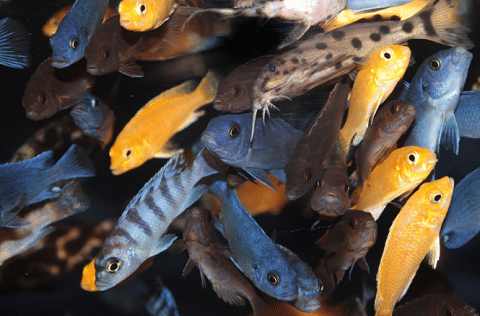
Mbuna species. Members of the Labidochromis, Pseudotropheus, and Melanochromis genera do best when kept together. These are colorful fish that can be mixed and matched in a 55 gallon aquarium. It is recommended to keep about 10 individuals per 55 gallon, paying extra attention to the stocking order.
Mbuna cichlids need plenty of rock in their aquarium to set up territories. The most aggressive species should be added last to prevent competition.
Aulonocara species. Peacocks are considered to be less aggressive than Mbuna species, but they’re still aggressive cichlids. In most cases, they can’t withstand the aggression of Mbunas, making these two species incompatible tank mates. Instead, peacock cichlids can be kept with each other, and more docile haps (Haplochormis spp.).
These fish also depend on the rockwork to form territories, so it’s important to incorporate plenty of caves and hiding spots for the fish. Aulonocara and Haplochormis have comparable aggression levels, but this may vary between specific species. Fish may be added together if they’re the same size, or be added later on according to size.
Lake Tanganyika tank mates
While Lake Tanganyika African cichlids are generally less aggressive than those from Lake Malawi, special attention is still needed to create successful tank mate pairings.
Shell-dwellers. There are a few different species of shell-dweller, including those from the Neolamprologus and Lamprologus genera. These freshwater fish defend their shell territories at the bottom of the tank, so tank mates should stay in the upper portions of the tank. Aggression can vary from species to species, but some tank mate options include:
- Sardine cichlid (Cyprichromis leptosoma)
- Julidochromis spp.
- Neolamprologus brichardi

Frontosas. These are some of the more peaceful fish on this African cichlid list, but they’re still capable of harassing and eating other fish. Frontosas do well in a species-only aquarium but can be kept with a few other Lake Tanganyika species, like the lemon cichlid or Judiochromis transcriptus. Some cichlid enthusiasts have even had luck keeping frontosas with shell-dwellers if the tank is set up with both species in mind.
Julidochromis spp.. Species from this genera can be kept with a few different African cichlids. Along with shell-dwellers and frontosas, Julidochromis could potentially be paired with sardine cichlids and Neolamprologus species.
Other African cichlid tank mates
In general, African cichlids should only be kept with related species. These are some of the most aggressive fish available in the hobby, and any fish tank mate pairing can fail. Because of this, hobbyists usually only recommend Synodontis catfish for these aggressive cichlid species.
Synodontis catfish (Synodontis spp.).These are nocturnal fish, which can help decrease the possibility of aggression. Some species only grow to be 4 inches, so they should not be kept with larger cichlids. They originate from Lake Tanganyika and do best with other endemic species, like frontosas and members of both Neolamprologus and Julidochromis. Popular species include S. lucipinnis, S. angelicus, and S. eupterus.
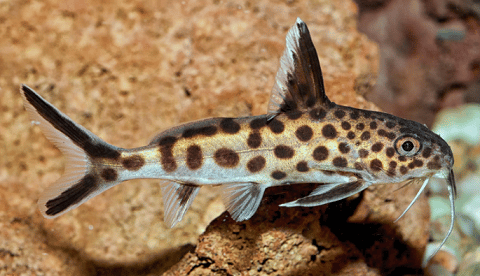
Given a large tank with plenty of hiding spots, Syndontis have also been successfully kept with Mbunas and Aulonocara peacocks.
Rainbowfish (Melanotaeniidae family). Some hobbyists add rainbowfish, like Boesemani (Melanotaenia boesemani), to their African cichlid tank setups. These smaller, fast-moving fish act as dither fish which can help diffuse overall aggression.
Central and South American Cichlids
If you want a little more wiggle room for cichlid tank mates, Central and South American species are generally much more peaceful than their African counterparts. For some of these cichlids, it’s still recommended to only keep other species from Central and South America.
Aggressive tank mates
Central and South American cichlids can greatly vary in size and aggression. Species like red devils and green terrors are large freshwater fish. Even if a given species is not aggressive, they will readily eat smaller fish.
Here are some of the best tank mates for large and/or aggressive Central and South American cichlids:
Giant gouramis (Osphronemus goramy). Giant gouramis need a giant tank. They reach impressive sizes and can become increasingly aggressive as they grow. While native to Southeast Asia, these fish can be kept in a cichlid tank with oscars, severums, and geophagus.
Catfish. Most species of catfish can be kept with both peaceful and aggressive cichlids. An aggressive Central and South American cichlid tank can house Synodontis catfish, Raphael catfish (Platydoras armatulus), Redtail catfish (Phractocephalus hemioliopterus), and Pictus catfish (Pimelodus pictus).
Keep in mind that some catfish, like the redtail catfish, can grow to extreme sizes.
Arowana (Osteoglossidae family). Arowanas are one of the largest fish available in the aquarium trade, but they’re relatively delicate. It is not unheard of for especially aggressive species to chase after and attack arowana. Unfortunately, arowanas can quickly succumb to injury. In return, large arowanas also have the potential to eat smaller, calmer cichlids. In some cases, this pairing can work.
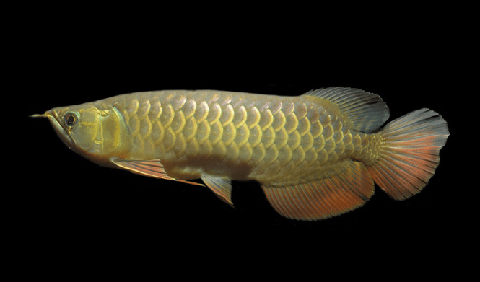
Other cichlids. The best cichlid pairings are ones that stay true to what you would find in their natural environment. Pick species that naturally occur in the same regions as your desired cichlid. Set up the tank so that each fish has its niche within that space. While this still isn’t guaranteed to work, it’s one of the best ways to approach any cichlid aquarium setup.
Community tank mates
It’s always risky adding more peaceful fish to a cichlid tank, but some hobbyists have made it work. These pairings will largely depend on the temperament of your freshwater fish, but success can be increased by providing plenty of hiding spots and paying close attention to interactions. Luckily, these species are usually much more peaceful than African cichlids, so there are some choices!
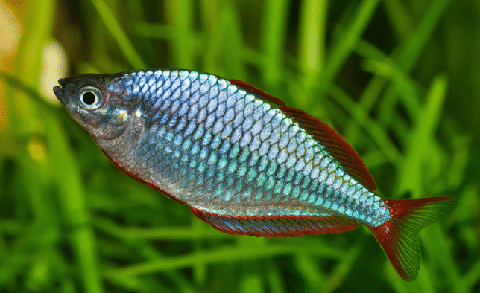
Here are some common community tank species that might fit in a Central or South American cichlid setup. Note any cichlid larger than 8 inches may consume them:
Giant danios (Devario aequipinnatus). Giant danios are possible tank mates for cichlids: they’re big, fast, and stay at the top of the water, away from predators. This doesn’t make them an instant success, however. Many hobbyists have found that their giant danio numbers start to dwindle the longer they stay in the tank. Make sure to watch out for aggression and be ready to rehome fish if necessary.
Rainbowfish. Species like the Boesemani rainbowfish (Melanotaenia boesemani), millennium rainbowfish (Glossolepis pseudoincisus), and the turquoise rainbowfish (Melanotaenia lacustris) have been known to make good tank mates for certain cichlids. Rainbows need to be kept in groups of at least 6 or more but are generally capable of escaping an attacking cichlid.
Swordtails (Xiphophorus hellerii). If you have cichlids that mind their own business, then swordtails could help bring some color and movement to the top of the aquarium. These fish are colorful and busy, but most importantly, they’re prolific. This is especially helpful as even if a cichlid goes after adults or eats the majority of fry, chances are that a swordtail population will be able to sustain itself.
Congo tetras (Phenacogrammus interruptus). Another similar option is the Congo tetra. These are moderately-sized schooling fish, just big enough to hold their own against a more territorial cichlid. Congo tetras are one of the few species of tetra that can be housed with cichlids, as anything smaller could be bullied or eaten.
Peaceful Cichlid Tank Mates
Some cichlids simply get along with fish while others are actually peaceful species. So much so that some hobbyists don’t even realize they’re cichlids, like freshwater angelfish! While African cichlids are still too aggressive to make this list, there are plenty of other Central and South American species that can successfully be added to a community tank.
Rams
The ram cichlid is a small South American species that can be kept and bred within a community tank setup. These fish only grow to about 4 inches, which means that they can be kept with both bigger and smaller species.
Some compatible ram cichlid tank mates include:
It’s important to note that ram cichlids prefer slightly higher water temperatures than normal, in the 78 to 85° F range. Tank mates should be able to adapt to these conditions without any ill effects.
Angelfish

Freshwater angelfish are arguably the most popular species of cichlid, though many hobbyists don’t even realize that they’re cichlids. These fish require some special care when choosing tank mates as they prefer slow-moving water conditions and cannot tolerate having their fins nipped.
These are some options to consider:
- Other angelfish
- Mollies
- Rainbowfish
- Corydoras catfish
- Molly Fish
- Certain tetras (Cardinal tetras, Rummynose tetras)
Discus
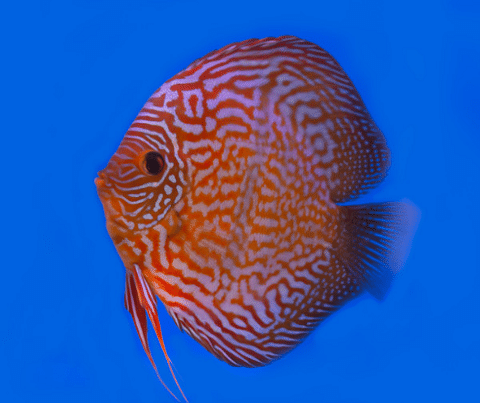
Discus are one of the more challenging species of aquarium fish to keep due to their need for near-pristine water parameters and higher water temperature ranges. Because of this, many hobbyists choose to keep discus in setups by themselves, but some have also had luck keeping them in community tanks.
Some suitable tank mates might be:
- Dwarf gouramis
- Corydoras catfish
- Ram cichlids
- Angelfish
- Certain tetras (Cardinal tetras, Rummynose tetras, Neon tetras)
Oscars
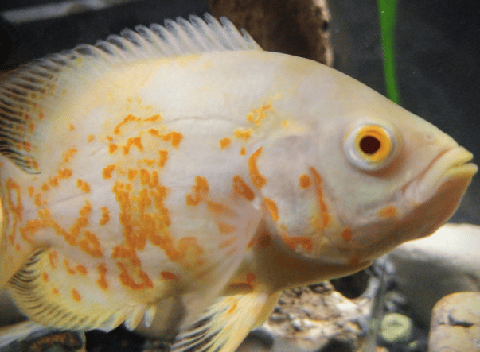
Oscars can be aggressive, but they don’t mean to be. Instead, these are gentle giants that need plenty of space for themselves and might mistake smaller fish for a meal. Given the right setup, they are very easy to care for and can be kept with a variety of species, including:
- Silver dollars
- Clown loaches
- Arowanas
- Other cichlids (Green terror, Jack Dempsey, Severums)
- Other oscars
Severums
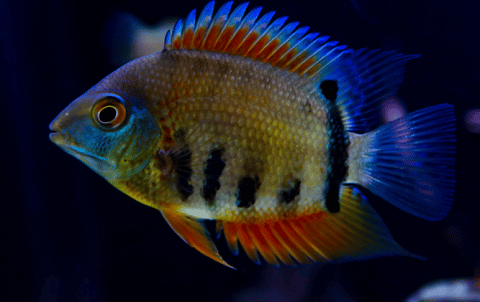
Severums are another relatively peaceful species of cichlid. These are large fish, growing to nearly 10 inches at adult size, but they can bring a lot of color and interest to a semi-aggressive community tank. They need a large tank, but can be kept with an assortment of:
- Silver dollars
- Denison barbs
- Pearl gouramis
- Oscars
- Other severums
FAQS
What kind of fish can be put with cichlids?
African cichlids have limited tank mates while Central and South American species can be kept with a bigger assortment. In general, African cichlids should only be kept with species that originate from the same regions. Central and South American species have greater flexibility for being mixed with each other and with other aquarium species.
Can you put a cichlid in a community tank?
Yes! Some cichlids can be kept in a community aquarium setting, like rams, angelfish, and discus. This means that they can be kept with more familiar tetras, cory catfish, and livebearers. However, more aggressive types, like African cichlids, should only be kept with each other.
Do cichlids eat other fish?
Yes, cichlids, especially large ones, can eat other fish. This isn’t entirely on purpose for some species, like the oscar, where curiosity gets the best of them. It is always safe to assume that if a fish can fit in another fish’s mouth, they could potentially become lunch.
African cichlids and more aggressive South American cichlids are more likely to chase and attack fish than they are to mistakingly eat them.
Can cichlids live with goldfish?
No! Cichlids can never live with goldfish. Goldfish are coldwater fish while cichlids prefer tropical and above tropical water temperature conditions. Many African cichlid species also prefer harder and more basic water conditions, which is incompatible with goldfish. Lastly, goldfish are gentle and relaxed while cichlids are active and territorial!
Conclusion
When setting up a cichlid tank, you need a plan. These are aggressive fish that have special considerations regarding water parameters, tank setup, and aggression. Tank mates will largely revolve around the type of cichlid you choose to keep. An African cichlid tank might only leave room for related species but an angelfish aquarium might allow space for a variety of community species.
Keep in mind that while one pairing works for another hobbyist it might not always work for you. Always be ready to rehome fish if necessary.
- About the Author
- Latest Posts
I’m thrilled that you found Aquarium Store Depot! Here you’ll find information on fish, aquariums, and all things aquatics related. I’m a hobbyist (being doing this since I was 11) and here to help other hobbyists thrive with their aquariums! I adhere to a high quality Editorial Process and Review products with real life field usage and practical analysis.





